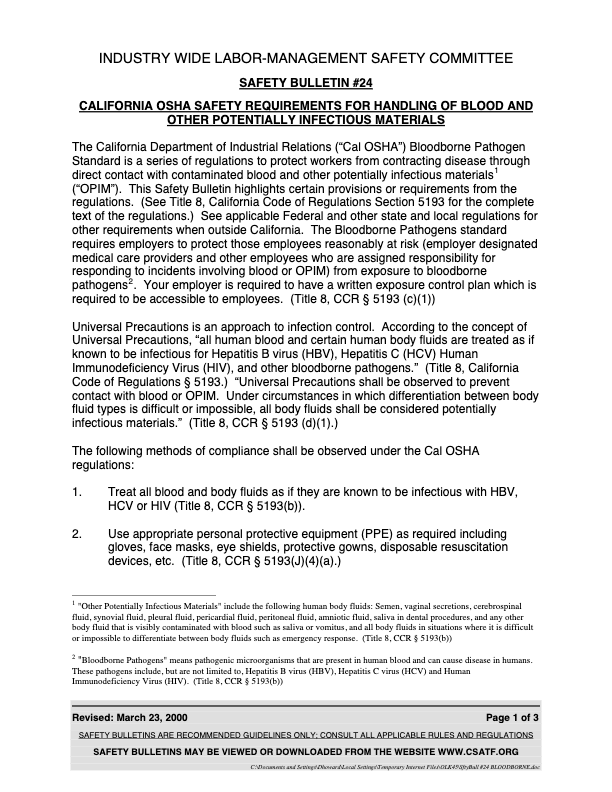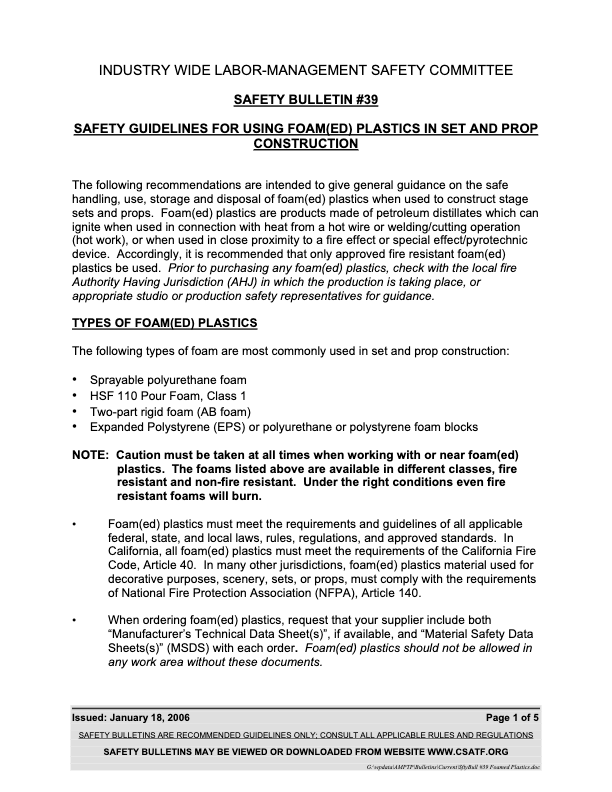Safety Bulletin

Guidelines
The California Department of Industrial Relations (“Cal OSHA”) Bloodborne Pathogen Standard is a series of regulations to protect workers from contracting disease through direct contact with contaminated blood and other potentially infectious materials (“OPIM”). This Safety Bulletin highlights certain provisions or requirements from the regulations. (See Title 8, California Code of Regulations Section 5193 for the complete text of the regulations.) See applicable Federal and other state and local regulations for other requirements when outside California. The Bloodborne Pathogens standard requires employers to protect those employees reasonably at risk (employer designated medical care providers and other employees who are assigned responsibility for responding to incidents involving blood or OPIM) from exposure to bloodborne pathogens. Your employer is required to have a written exposure control plan which is required to be accessible to employees. (Title 8, CCR § 5193 (c)(1))
Universal Precautions is an approach to infection control. According to the concept of Universal Precautions, all human blood and certain human body fluids are treated as if known to be infectious for Hepatitis B virus (HBV), Hepatitis C (HCV), Human Immunodeficiency Virus (HIV), and other bloodborne pathogens. Precautions shall be observed to prevent contact with blood or other potentially infectious materials, including semen, vaginal secretions, cerebrospinal fluid, synovial fluid, pleural fluid, pericardial fluid, peritoneal fluid, amniotic fluid, saliva in dental procedures, and any other body fluid that is visibly contaminated with blood such as saliva or vomitus, and all body fluids in situations where it is difficult or impossible to differentiate between body fluids such as emergency response. Under circumstances in which differentiation between body fluid types is difficult or impossible, all body fluids shall be considered potentially infectious materials.
The following methods of compliance shall be observed:
- Treat all blood and body fluids as if they are known to be infectious with HBV, HCV or HIV.
- Use appropriate personal protective equipment (PPE) as required including gloves, face masks, eye shields, protective gowns, disposable resuscitation devices, etc.
- Efficient hand washing is the single most effective practice to prevent the spread of infection. Wash your hands immediately or as soon as feasible, after removal of gloves or other personal protective equipment (PPE). When provision of hand washing facilities is not feasible, the employer shall provide either an appropriate antiseptic hand cleanser in conjunction with clean cloth/paper towels or antiseptic towelettes. When antiseptic hand cleansers or towelettes are used, hands shall be washed with soap and running water as soon as feasible.
- Treat all needles and other sharp implements as if they are known to be contaminated with infectious material.
- Be sure that ALL biohazard waste including contaminated PPE and sharps are disposed of properly and safely (dispose of sharps in puncture-proof containers). Refer to your employer’s written exposure control plan for details.
- If you have an “Occupational Exposure” or if you have an “Exposure Incident” and are accidentally exposed to blood or other potentially infectious materials, a series of Hepatitis B vaccinations and post-exposure evaluation and follow-up will be offered to you at that time. The cost of these vaccinations is the responsibility of your employer. If you have an exposure, report the incident immediately to your supervisor and to first-aid personnel. “Occupational Exposure” means reasonably anticipated skin, eye, mucous membrane, or parenteral contact with blood or other potentially infectious materials that may result from the performance of an employee’s duties. “Exposure Incident” means a specific eye, mouth, or mucous membrane, non-intact skin, or parenteral contact with blood or other potentially infectious material that results from the performance of an employee’s duties.
The key to protection and prevention is compliance with regulations and universal precautions. Your health and safety may depend on it!

